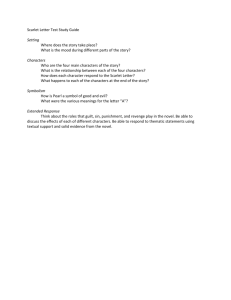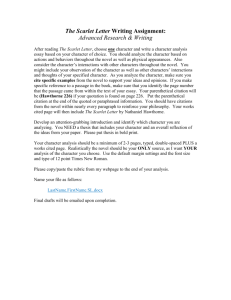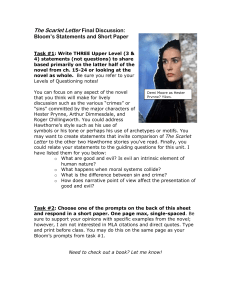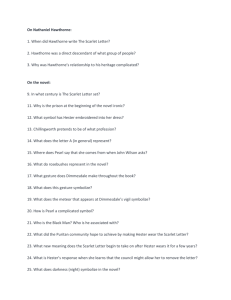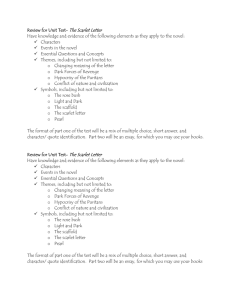The Scarlet Letter
advertisement
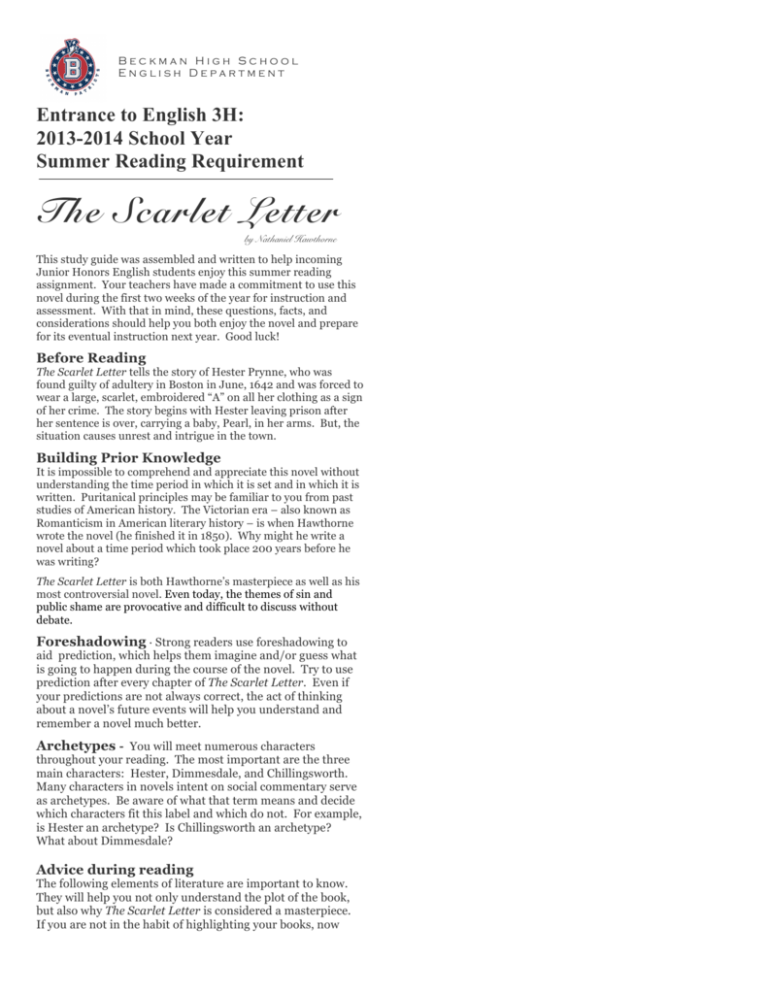
Beckman High School English Department Entrance to English 3H: 2013-2014 School Year Summer Reading Requirement The Scarlet Letter by Nathaniel Hawthorne This study guide was assembled and written to help incoming Junior Honors English students enjoy this summer reading assignment. Your teachers have made a commitment to use this novel during the first two weeks of the year for instruction and assessment. With that in mind, these questions, facts, and considerations should help you both enjoy the novel and prepare for its eventual instruction next year. Good luck! Before Reading The Scarlet Letter tells the story of Hester Prynne, who was found guilty of adultery in Boston in June, 1642 and was forced to wear a large, scarlet, embroidered “A” on all her clothing as a sign of her crime. The story begins with Hester leaving prison after her sentence is over, carrying a baby, Pearl, in her arms. But, the situation causes unrest and intrigue in the town. Building Prior Knowledge It is impossible to comprehend and appreciate this novel without understanding the time period in which it is set and in which it is written. Puritanical principles may be familiar to you from past studies of American history. The Victorian era – also known as Romanticism in American literary history – is when Hawthorne wrote the novel (he finished it in 1850). Why might he write a novel about a time period which took place 200 years before he was writing? The Scarlet Letter is both Hawthorne’s masterpiece as well as his most controversial novel. Even today, the themes of sin and public shame are provocative and difficult to discuss without debate. Foreshadowing · Strong readers use foreshadowing to aid prediction, which helps them imagine and/or guess what is going to happen during the course of the novel. Try to use prediction after every chapter of The Scarlet Letter. Even if your predictions are not always correct, the act of thinking about a novel’s future events will help you understand and remember a novel much better. Archetypes - You will meet numerous characters throughout your reading. The most important are the three main characters: Hester, Dimmesdale, and Chillingsworth. Many characters in novels intent on social commentary serve as archetypes. Be aware of what that term means and decide which characters fit this label and which do not. For example, is Hester an archetype? Is Chillingsworth an archetype? What about Dimmesdale? Advice during reading The following elements of literature are important to know. They will help you not only understand the plot of the book, but also why The Scarlet Letter is considered a masterpiece. If you are not in the habit of highlighting your books, now might be a good time to start. Most importantly, form an opinion about the novel and be prepared to support your opinion using textual evidence, insight, and your own personal experience. Motifs are present in almost all novels. They are elements of the plot or literary devices that occur over and over. They help the reader determine the theme of the novel – what the author really wants you to consider and contemplate after reading the book. Literary guides, for example, usually identify only three motifs in the novel, but there is strong evidence to suggest that there are others. Be prepared to discuss at least one other motif in the novel, with evidence to support your claim. There are multiples themes to this novel, as is the case with many well-regarded works of literature. Identifying two or three potential themes – and determining the best evidence to support their identification as a theme – will be one of your responsibilities next year in class. Yet, it is relatively easy to forward a theme for a novel after it has been read. A much better question is: HOW is the theme revealed? How does Hawthorne establish one or more of his themes? Is it through the use of literary devices? Is it through the use of diction? Is it through tone? Be prepared to discuss these questions. In fact, the ability to independently answer questions like these is often the best predictor of future success in English 3H. Symbols In almost all novels, characters do not serve as symbols. However, in The Scarlet Letter, a case can be made for Pearl’s classification as both character and symbol. Why? What is it about her actions, demeanor, name, and function which might make her symbolic? Questions to consider after reading: 1. Discuss the development of Hester Prynne as a character. How does she grow throughout the book? What effects do Chillingsworth’s schemes have on the development of her character? How does she interact with Dimmesdale…and how do their interactions change as the novel progresses? 2. Discuss the ending of the novel. Does it fit aesthetically and/or thematically with the rest of the book? Does Hester receive justice? 3. The arc of American literature, as well as the development of American values and beliefs, is a focal point for English 3H. What does this novel tell you about America in the 1640s (when it is set) and 1850s (when it was written)? Is it an accurate snapshot of American culture during both those eras? Why or why not? 4. Does this novel deserve the title of masterpiece? Why or why not? 5. Diction is a key component of literary analysis in English 3H. Can you identify five strong examples of diction in The Scarlet Letter and explain why each is a meaningful example? 6. Syntax is a also key component of literary analysis in English 3H. What do you notice about Hawthorne’s syntax? Can you identify one representative sample of a syntactical structure which Hawthorne employs in The Scarlet Letter? Can you explain what he was trying to accomplish by writing sentences this way?
